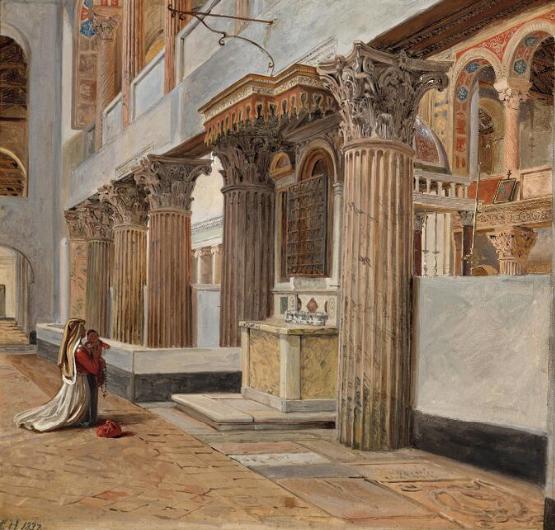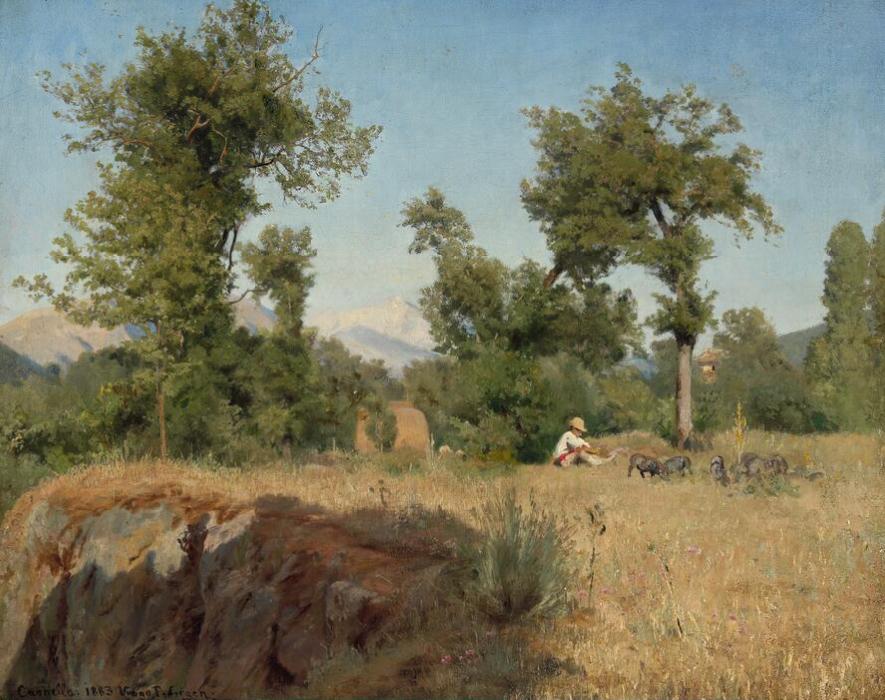Constantin Hansen and Viggo Pedersen represent two different chapters in Danish art history: the Golden Age and the Modern Breakthrough. Thus, the two paintings are very different, even though they were both created in Italy, and each makes a significant contributions to the collection of Ribe Art Museum. In addition to being 50 years Pedersen’s senior, Hansen spent much of his time in Rome, which naturally influenced his focus on architectural and historical topics. Pedersen, on the other hand, lived and painted in the small town of Sora south-east of Rome. His art revolves more around nature and Italian country living.
Architectural art
Before leaving for Italy, Hansen had mainly painted portraits, but while in Italy he began to take an interest in architecture as a topic as well as in decorative projects. He drew inspiration from the many examples of ancient Roman architecture, and his grasp of the field may benefited from his study of architecture at the Royal Danish Academy of Fine Arts. Hansen spent eight years in Italy, and the paintings he created during this time are among the most renowned Danish paintings from the country.
Det indre af kirken S. Lorenzo Fuori i Rom (Interior from S. Lorenzo Fuori church in Rome) is a study with a taut but dynamic composition. Due to the oblique perspective, the painting is cut through by several diagonal lines. These lines are both broken up and supported by the heavy pillars, which form a line concluding in the picture’s vanishing point. The pillars divide the church into two spaces. Behind the pillars, the many nooks and corners of the church are glimpsed, and in front, a woman, holding a child, is kneeling. In relation to the spatial proportions of the church, the female figure seems delicate and exposed, inviting reflection on the relationship between the individual person and the Catholic church.
Landscape art
Pedersen’s Italiensk landskab i nærheden af Carnello (Italian landscape near Carnello) was painted in 1883, more than forty years after Hansen’s study. Pedersen’s painting also shows a human being who is subordinate to a higher power, only this time, the higher power is nature. A small figure, a boy, is sitting in a field of yellow grass next to a herd of black pigs, enveloped by a beautiful natural scenery of mountains and open land. This painting too is divided into two sections. A row of trees separates the little boy from the mountains in the background, creating an intimate space in the foreground of the painting. Pedersen’s use of colours – the sky ranging from deep blue to white, the yellow grass – makes it seem as if the sun is virtually shining out of the picture. This grasp of colours was something he learned during his stay in Sora, where he exchanged experiences with the many other artists in the town.
About Constantin Hansen and Viggo Pedersen
Constantin Hansen (1804–1880) was born in Rome but moved to Denmark early and attended the Royal Danish Academy of Fine Arts from a young age. The acclaimed Danish artist C. W. Eckersberg was one of his teachers, and his influence is evident in Hansen’s art. In 1835, Hansen received a grant for a two-year stay in Italy. This sojourn became a turning point for him, and he ended up staying much longer than originally planned. When he finally returned to Denmark, it was to carry out a major commission for an al fresco decoration in the lobby of the University of Copenhagen; an important work that drew inspiration from his time in Italy, both in technique and his choice of topics.
Viggo Pedersen (1884–1926) learned drawing at C. V. Nielsen’s art school and subsequently developed his technique and style on trips to France and Italy. In particular, his stay in Italy, along with Danish artists Kristian Zahrtmann and Theodor Philipsen, influenced his treatment of colours and light, as seen in his paintings from there. After his return to Denmark Pedersen became part of the artist group that broke with the annual juried exhibition at Charlottenborg in 1891 and founded Den Frie Exhibition (The Free Exhibition). He remained a member of this group for the rest of his life.
Ribe Art Museum purchased the paintings at auction with support from the New Carlsberg Foundation.




